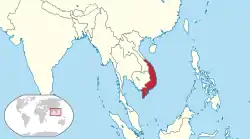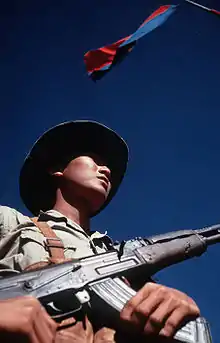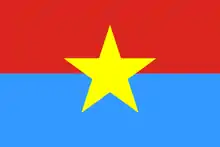Provisional Revolutionary Government of the Republic of South Vietnam
The Provisional Revolutionary Government of the Republic of South Vietnam (Vietnamese: Chính-phủ Cách-mạng Lâm-thời Cộng-hòa Miền Nam Việt-nam, PRG), was formed on June 8, 1969, by North Vietnam as a purportedly independent shadow government that opposed the government of the Republic of Vietnam under President Nguyễn Văn Thiệu and as a country after the fall of Saigon with the name Republic of South Vietnam from 30 April 1975 to 2 July 1976. Delegates of the National Liberation Front (the Viet Cong), as well as several smaller groups, participated in its creation.
Republic of South Vietnam Cộng hòa Miền Nam Việt Nam | |||||||||
|---|---|---|---|---|---|---|---|---|---|
| 1969–1976 | |||||||||
 Emblem
| |||||||||
 | |||||||||
| Status | Underground government in opposition to the Republic of Vietnam (1969–75) Associated state of the Democratic Republic of Vietnam (1975–76) | ||||||||
| Capital | Tây Ninh (1968-1972) Lộc Ninh (1972-73) Cam Lộ (1973-1975) Saigon (1975-76) | ||||||||
| Common languages | Vietnamese | ||||||||
| Religion | Buddhism Confucianism Taoism | ||||||||
| Government | Unitary Marxist–Leninist transitional government | ||||||||
| Head of state | |||||||||
• 1969–1976 | Nguyễn Hữu Thọ | ||||||||
| Head of government | |||||||||
• 1969–1976 | Huỳnh Tấn Phát | ||||||||
| Historical era | Vietnam War · Cold War | ||||||||
• Government formed | 8 June 1969 | ||||||||
| 30 April 1975 | |||||||||
| 2 July 1976 | |||||||||
| Area | |||||||||
| 1973 | 173,809 km2 (67,108 sq mi) | ||||||||
| Population | |||||||||
• 1973 | 19,370,000 | ||||||||
| Currency | Liberation dong[2] (official) RVN dong (reality) | ||||||||
| |||||||||
| Today part of | |||||||||
Part of a series on the |
|---|
| History of Vietnam |
 |
| Timeline |
|
|
The PRG was recognized as the government of South Vietnam by most communist states. It signed the 1973 Paris Peace Treaty as an independent entity, that was separate from both South Vietnam and North Vietnam. It became the provisional government of South Vietnam as the name Republic of South Vietnam following the military defeat of the Army of the Republic of Vietnam on 30 April 1975. On 2 July 1976, Republic of South Vietnam and North Vietnam merged to form the Socialist Republic of Vietnam.
History
The Provisional Revolutionary Government was preceded by the Vietnam Alliance of National, Democratic, and Peaceful Forces (VANDPF)[3] made up of anti-government forces and headed by Trinh Dinh Thao.[4] The Alliance was a collection of individuals who wanted a new South Vietnamese government but disagreed with the ever-present Northern Communist presence.
There had been talk of setting up an Alliance as early as 1966, but this was halted when South Vietnamese intelligence operatives arrested an influential anti-government organizer, Ba Tra. Ba Tra gave the South Vietnamese government extensive information on anti-government forces working in the city.[5] This setback was compounded by his identification of one of the key cadre in the financial division.[5]
Under torture, Ba Tra identified more figures in the underground, who were then arrested. By 1967, the entire Saigon organization had been sent further underground.[6] The Tet Offensive during 1968 triggered a wave of oppression, forcing many people into the jungle. These people – businessmen, middle class, doctors and other professionals – started The Alliance.
The then-new American president, Richard Nixon, started a process of Vietnamization to allow the American Armed Forces to withdraw from Vietnam. One of the tenets of Vietnamization was responsible government in South Vietnam. To prevent the Americans from installing their own government, a conference was held on June 6–8, 1969, off Route 22 in Cambodia's Fishhook region.[7]
1969-1975
The Alliance as well as other groups met and formed the Provisional Revolutionary Government on June 8, 1969. According to Justice Minister Trương Như Tảng, the new group's main purpose was to help the Vietcong "acquire a new international stature."[8]
There were delegates from the NLF, the VANDPF, the People's Revolutionary Party (the South Vietnamese communist party) and "the usual assortment of mass organizations, ethnic groups, and geopolitical regions."[7] Banners displayed prominently at the convention proclaimed that "South Vietnam is independent, democratic, peaceful, and neutral".[7]
The PRG reflected a number of nationalist, anti-imperialist and communist political viewpoints, including those of the Vietnam Workers Party (the North Vietnamese communist party). Following the military and political results of the 1968 Tet Offensive and related military offensives in the South, in which the Vietcong suffered serious military losses, the PRG was envisioned as a political counter-force that could influence international public opinion in support of reunification and in opposition to the United States and the Republic of Vietnam.[8]
The declared purpose of the PRG was to provide a formal governmental structure to the National Liberation Front and enhance its claim of representing "the Southern people".[9] Included in this strategy was the pursuit of a negotiated settlement to the war leading to reunification, organized during the initial phase of Vietnamization.
During the period 1969–70, most of the PRG's cabinet ministries operated near the Cambodian border. Starting on March 29 to late April 1970, the US and South Vietnamese offensives forced the PRG to flee deeper into Cambodia. The stressful escape caused many of the PRG officials (such as Trương Như Tạng) to need extensive medical furloughs. After Trương Như Tạng returned, he noticed that new cadres from the north were causing problems for the non-communist members of the PRG.[10] One member in particular, Ba Cap, harshly denounced most of the PRG as bourgeois.[11] Tạng complained to the higher members of the North Vietnamese government, but was rebuffed. Tạng later saw this as the point when the PRG turned from being an independent South Vietnam-based alternative government to being a mouthpiece for Northern Vietnamese communists.[12]
The central bodies of the PRG functioned as a provisional government. The PRG maintained diplomatic relations with many countries of the Non-Aligned Movement, such as Algeria, as well as with the Soviet Union and the People's Republic of China.
- 1975 - 1976
After the surrender of Saigon on 30 April 1975, the PRG assumed power in the South and subsequently participated in the reunification of Vietnam.
According to professor Long Vinh Ngo (University of Maine), mid-July 1975, the delegates of the Democratic Republic of Vietnam (Nguyễn Văn Lưu) and the Republic of South Vietnam (Đinh Bá Thi) applied to join the United Nations as two independent member states. On 11 August 1975, the United Nations Security Council introduced a referendum on reunification, which passed. The two Vietnamese countries eventually reunited on 2 July 1976.
Culture
Anthem
The national anthem of the Government was To Liberate the South (Vietnamese: Giải phóng miền Nam). The song was written in 1961 by Lưu Hữu Phước (1921–1989) and adopted at that time as the anthem of the National Front for the Liberation of Vietnam.
Giải phóng miền Nam, chúng ta cùng quyết tiến bước, Vùng lên, nhân dân miền Nam anh hùng, |
To liberate the South, together we advance. Arise! Oh you brave people of the South! |
Photos

 A youth representative of the PRG greets a young man from a Soviet-aligned unidentified African nation. Both are attending a 1973 World Youth Conference held in East Germany and organised by the Free German Youth.
A youth representative of the PRG greets a young man from a Soviet-aligned unidentified African nation. Both are attending a 1973 World Youth Conference held in East Germany and organised by the Free German Youth. 1973 World Youth Conference held in East Berlin, 4 August 1973
1973 World Youth Conference held in East Berlin, 4 August 1973 Signes of two primers Nguyễn Duy Trinh (North) and Nguyễn Thị Bình (South) at the Paris Peace Accords, 27 January 1973
Signes of two primers Nguyễn Duy Trinh (North) and Nguyễn Thị Bình (South) at the Paris Peace Accords, 27 January 1973 VC soldier on 12 February 1973
VC soldier on 12 February 1973
Personnel
| Post | Name | Took office | Left office | Party |
|---|---|---|---|---|
| Chairman of Consultative Council (President) | Nguyễn Hữu Thọ | 6 June 1969 | 2 July 1976 | People's Revolutionary Party and Democratic Party of Vietnam |
| Chairman of Government (Prime Minister) | Huỳnh Tấn Phát | 8 June 1969 | 2 July 1976 | People's Revolutionary Party and Democratic Party of Vietnam |
| Vice-Chairman | Phung Van Cung | 8 June 1969 | 1976 | Democratic Party of Vietnam |
| Vice-Chairman | Nguyễn Văn Kiệt | 8 June 1969 | 1976 | |
| Vice-Chairman | Nguyen Doa | 8 June 1969 | 1976 | |
| Minister of Presidential Palace of Government | Tran Buu Kiem | 8 June 1969 | 1976 | People's Revolutionary Party and Democratic Party of Vietnam |
| Minister of Defense | Trần Nam Trung | 8 June 1969 | 1976 | People's Revolutionary Party |
| Minister of Foreign Affairs | Nguyễn Thị Bình | 8 June 1969 | 1976 | People's Revolutionary Party |
| Minister of the Interior | Phung Van Cung | 8 June 1969 | 1976 | |
| Minister of Justice | Trương Như Tảng | 8 June 1969 | 1976 | |
| Minister of Economy and Finance | Cao Van Bon Duong Ky Hiep (acting since 1975) | 8 June 1969 | died 1971 | |
| Minister of Information and Culture | Lưu Hữu Phước | 8 June 1969 | 1976 | |
| Minister of Education and Youth | Nguyễn Văn Kiệt | 8 June 1969 | 1976 | |
| Minister of Health, Social Action and Disabled Soldiers | Dương Quỳnh Hoa | 8 June 1969 | 1976 | People's Revolutionary Party |
See also
References
- "giấy công tác đặc biệt".
độc lập -- dân chủ -- hòa bình -- trung lập
(English title: Special Working Paper) - Liberation dong was invalid because the Republic of South Vietnam had got no economy and banks.
- Florian Grotz; Dieter Nohlen; Christof Hartmann, eds. (2001). Elections in Asia and the Pacific : A Data Handbook | Volume II: South East Asia, East Asia, and the South Pacific. OUP Oxford. pp. 333, 334, 337.
- Porter 1993, pp. 27–29
- Tảng 1985, p. 131
- Tảng 1985, p. 132
- Tảng 1985, p. 147
- Tảng 1985, p. 146
- Tảng 1985, pp. 146–147
- Tảng 1985, p. 186
- Tảng 1985, p. 188
- Tảng 1985, pp. 188–189
Documents
- Porter, Gareth (1993). Vietnam: the politics of bureaucratic socialism (1993 ed.). Cornell University Press. ISBN 978-0-8014-2168-6. - Total pages: 227
- Tảng, Truong Như; David Chanoff, Van Toai Doan (1985). A Vietcong memoir (1985 ed.). Harcourt Brace Jovanovich. ISBN 978-0-15-193636-6.- Total pages: 350
Data
- Provisional Revolutionary Government of South Vietnam (1969-1975)
- "Ethnic Music" Room ("Words" is Japanese version only.)
- Rulers (Vietnam)
- WORLD STATESMEN, Vietnam (including South Vietnam)
| Preceded by Republic of Việt Nam |
Provisional Revolutionary Government 1975 – 1976 |
Succeeded by Socialist Republic of Vietnam |
